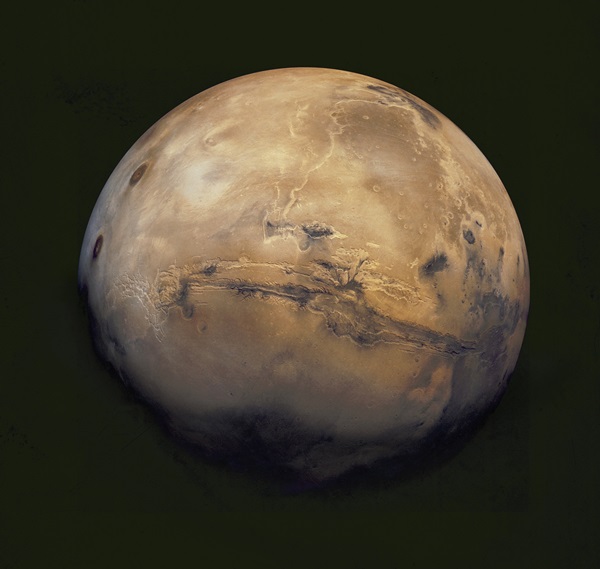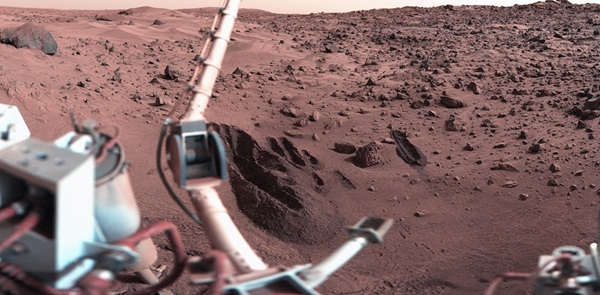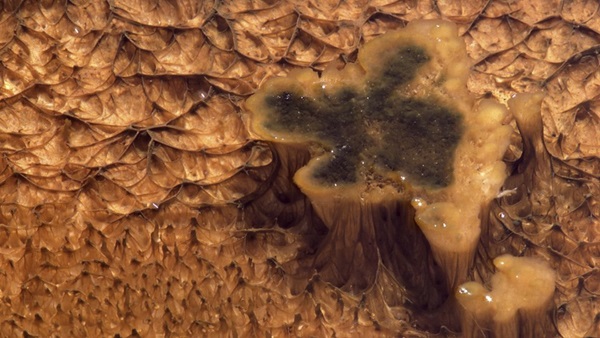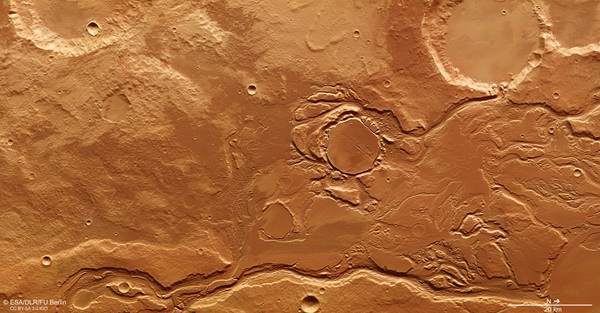Key Takeaways:

Bringing the universe to your door. We’re excited to announce Astronomy magazine’s new Space and Beyond subscription box – a quarterly adventure, curated with an astronomy-themed collection in every box. Learn More >>.
All these features support the hypothesis of Mars’ habitability because they invoke the presence of liquid water. Along with the existence of energy sources and organic molecules, water is one of the three key ingredients necessary for life as we know it.
Perhaps there was a period in the first billion years or so of the planet’s history when the environment was significantly warmer and the atmospheric pressure at the surface was much higher than it is now. Today, Mars’ average temperatures fall well below freezing and the atmospheric pressure is nearly 100 times lower than Earth’s. The melting of subsurface ice and glaciers, or even rainfall, might have allowed significant amounts of liquid water to interact with the landscape over potentially lengthy spans of geologic time during such periods.
Learning whether Mars was, or still is, habitable has been a major focus of the astrobiological exploration of the Red Planet for the past few decades. Since the answer appears to be yes, the focus for future Mars exploration is turning toward asking the obvious follow-up question: Was there ever life on Mars, and is there anything alive there today?
The twin Viking landers of the 1970s took a direct and somewhat risky approach to testing the hypothesis that life exists on Mars. The Vikings scooped up fine dust and soil from sites that were safe to land in but somewhat geologically unknown, and then performed organic chemistry and mass spectroscopy experiments on those materials. Given what was known at the time, the science team was taking a reasonable chance that the martian environment harbored no processes that would destroy organic molecules at the surface, and that the landing sites represented places that might have been or still were habitable.
The Viking biology results came out either negative or ambiguous. This soured many researchers on the prospects for life on Mars for several decades. However, the discoveries made by later missions have shown that neither assumption made in the Viking-era search for life was valid. Specifically, neither landing site shows any particularly strong geologic or compositional evidence that it might have been a promising place for either the existence or preservation of past (or present) life-forms.
In addition, the discoveries made by the Vikings and subsequent missions revealed not only that high-energy ultraviolet radiation from the Sun continuously bathes the surface and breaks down organic molecules, but also that the soils and dust are laced with a strongly oxidizing compound — identified as perchlorate by the 2008 Phoenix Mars lander team — that also breaks down organic molecules. In retrospect, it shouldn’t have been a surprise that the Vikings’ search for organic compounds came up blank.
These findings opened up a new, two-pronged pathway in the search for martian life. First, scientists would need to find places whose geology or composition suggests that they are or once were habitable. Second, researchers would have to devise search strategies that could focus on sampling materials from beneath the surface that have had little or no exposure to the current harsh-for-organics surface environment. Sifting through data from more than a dozen successful orbiter, lander, and rover missions since the Vikings, geologists, geochemists, and mineralogists have helped resurrect the search for life on Mars using this approach.
Those missions have identified a diverse range of potentially habitable environments well beyond what scientists knew about based on Viking and earlier results. In particular, researchers have been able to interpret past and present environmental conditions through detailed spectroscopic measurements of the composition of the surface.
Mars as a living world?
The 1989 Russian Phobos 2 mission, the first successful Mars orbiter after Viking, acquired a number of high-resolution infrared spectra of the surface that revealed evidence for water or hydroxyl within specific kinds of clay minerals. This suggested that water interacted with rock in specific places early in Mars’ history. Images from NASA’s Mars Global Surveyor spacecraft (1999–2006), at 10 to 100 times better resolution than the Viking orbiters achieved, provided a detailed geologic context on those specific places, showing that they often associate with water-carved landforms, sedimentary layers, or both.
The ongoing Mars Reconnaissance Orbiter (MRO) mission has expanded on those earlier discoveries. Using even higher-resolution imaging and spectroscopy, this NASA spacecraft has uncovered the most diverse set of potentially habitable environments on Mars. In particular, MRO has found sedimentary layers all over the planet that contain hydrated minerals (those chemically united with water) like iron-bearing sulfates and silica materials like opal, as well as clays rich in iron, magnesium, and aluminum.
Indeed, astrobiologists studying our own planet have also played an important role in resuscitating the search for life on Mars. Over the past few decades, they have helped revolutionize our understanding of the limits of both simple and complex life on Earth. In particular, the study of extremophiles — organisms that can thrive in extreme temperatures, pressures, salinity, acidity, and/or radiation — has made the idea of ancient or even existing life in an extreme environment like the subsurface of Mars more mainstream than ever.
Roving Mars
Those discoveries have amplified the importance of the close-up lander and rover studies conducted at six additional landing sites since the two Vikings set down in 1976. Of particular relevance to the search for life have been the incredible journeys of three NASA rovers — Spirit, Opportunity, and Curiosity — each of which found minerals occurring as layers of sandstones or other fine-grained sedimentary rocks that point to the intimate interactions between these rocks and surface water and/or groundwater.
The Opportunity rover made related discoveries during its more than 14-year traverse across the flat, cratered plains of Meridiani Planum. Scientists found evidence that abundant surface water and groundwater altered the pre-existing volcanic rocks, and the specific minerals identified showed that the water varied from somewhat acidic to more typical freshwater along the rover’s path. Using crater walls as probes into the subsurface, the rover team found the record of Meridiani’s watery past extends many tens to hundreds of meters underground, suggesting the environment would have been habitable over significant amounts of geologic time. Again, however, Opportunity uncovered no specific evidence of extinct or existing life. Like Spirit, it did not carry any instruments capable of making a detailed analysis of organic molecules.
The Curiosity mission is in the middle of perhaps the most ambitious effort yet to search for evidence of life on the surface and shallow subsurface of Mars. Since 2012, this rover has been exploring an enormous mound of sedimentary deposits containing clays, sulfates, and iron oxides in Gale Crater. Curiosity carries sophisticated chemical, mineralogic, and organic detection instruments as well as a drill that can penetrate the uppermost 2 inches (5 centimeters) of the subsurface. The rover is exploring an eroding landscape in which some of the sedimentary layers have been buried for perhaps billions of years before being exposed relatively recently. As such, drilling and sampling these layers provides a way to study materials that have been protected from much of the harmful ultraviolet radiation and oxidizing perchlorates for much longer than many other places on Mars.
The future of life on Mars
The next best effort will begin in 2020, when NASA will launch a still-unnamed rover toward Jezero Crater, an ancient basin where a beautifully preserved river delta once flowed its sediments into a shallow sea. On Earth, such deltas are excellent environments for preserving organic materials and even fossils transported by gentle downstream currents. By exploring such an environment and drilling into the delta’s layers, scientists will maximize their chances of finding evidence of past or present life on Mars.
Even better, NASA intends to store the Jezero drill samples in a few dozen core tubes that will be cached on the surface. Then, later in the 2020s, a future rover will collect and launch them in a capsule to Mars orbit, where another orbiter will capture the capsule and deliver it to Earth. Back here, in laboratories much more sophisticated than any we could currently deploy on Mars, those samples will be interrogated for the subtlest signs of complex organic molecules or other potential chemical or isotopic biosignatures. Such a Mars sample return mission would be the next step in searching for life on the Red Planet.
Beyond the 2020s, NASA and SpaceX are contemplating human missions to Mars. Such ventures would likely target mid-latitude regions where there’s enough sunlight to provide adequate power and where ground ice could be mined most easily to help sustain a small initial settlement. The presence of ground ice, and the potential for past or present associated groundwater, means such places also could be habitable. Bringing human explorers — with their associated expertise, intuition, and expanded capabilities for accessing the subsurface — into those kinds of environments could represent the next giant leap in the search for life on Mars.

















